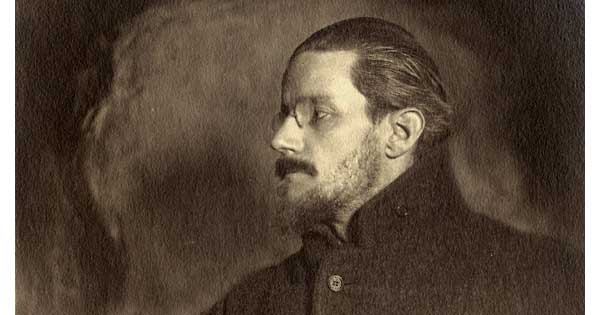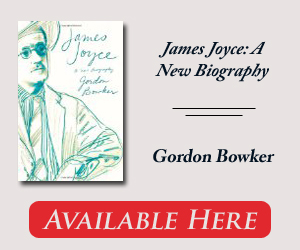
James Joyce: A New Biography, By Gordon Bowker Farrar, Straus and Giroux, 608 pp., $35
James Joyce is an irresistible biographical subject, a figure whose trials and triumphs make up an immensely appealing romance. The firstborn child of a family whose decline into dysfunction he witnessed with pity and rage, he left his native Ireland to seek his fortune in foreign parts. The ensuing odyssey took him to outposts of empire as ostensibly obscure and unpromising as the Dublin he disdainfully abandoned, until at last he became a feted figure in the Paris of the 1920s, then world capital of culture. Along the way he became a writer who, as his brother Stanislaus justly said, produced nothing but masterpieces, overcoming every obstacle—penury, censorship, war, ill health—to become the most innovative and influential 20th-century writer of imaginative prose in English (to call him a novelist belittles his achievements) and a talisman of artistic integrity whose works are standard-bearers for such values as self-expression, free speech, and author’s rights.
The works themselves are also odysseys, risky journeys through unfamiliar contexts and along uncertain linguistic pathways into realms of consciousness hitherto uncharted by literature and indeed considered off-limits for any writer worthy of the name. Joyce’s dissolving of barriers between high aesthetic method and low raw material, his exposure of the clichés and conventions of a reality rooted in the cultural conditioning of church and state, his bridging the distance between his city of origin (“the center of paralysis,” as he called it) and audiences in the world’s most cultivated salons seem in retrospect to resemble the legendary achievement of a knight errant—quixotic in ambition, heroic in attainment. And by seemingly eliminating the difference between life and work through frankly basing a good deal of his fiction in autobiography, Joyce further colors and complicates the actual and the artistic epic of himself.
The sheer unlikelihood of this career makes it not surprising that Gordon Bowker cites, in an incomplete list, eight earlier Joyce biographies. Of these, the best-known—and best—remains Richard Ellmann’s James Joyce (1959), a landmark in Joyce scholarship as well as a document of some cultural significance in its own right, both for the impetus it gave to American interest in modern Irish literature and for providing a prototype for what might be called the CinemaScope form of contemporary biography—broad-scale, lengthy, and open in various senses of the term. But it is 30 years since the revised edition of that work appeared, and in the interim a certain amount of fresh archival and scholarly material has become available, making a new biography a worthwhile project and creating the reasonable expectation that its appearance would be good news. Unfortunately, James Joyce: A New Biography disappoints that expectation.
Not that Bowker’s book has nothing to recommend it. As a professional biographer, with lives of Malcolm Lowry and George Orwell to his name, he knows how to organize material accessibly. There is a clear chronology and an assured, if somewhat mechanical, sense of momentum. The nuts and bolts of the life and times—Joyce’s innumerable changes of address, the state of his finances, the complications of his unremitting eye troubles, and much, much more—are all adroitly inserted. And Bowker writes in a style that, while not free from solecism, portentous foreshadowing, and peculiar associations, is basically clear and direct, well suited to the general reader, whose familiarity with Joyce’s work may well be a distant second to his curiosity about the life. Unlike Ellmann, Bowker is not a literary critic, at least not on this showing; his sense of Joyce’s works as artistic and cultural accomplishments is no more than dutiful—or, as in its impressive citations from Finnegans Wake, strategic. Lack of critical commentary contributes to the book’s brisk narrative pace, but it also creates a sense of remoteness between author and subject, which is also evident in Bowker’s limited interest in the cultural contexts from which Joyce emerged, as well as for those in which his imagination took wing.
By confining itself to a biographical approach, Bowker limits the life depicted. His is an earthbound Joyce in whom body outweighs mind; less Dedalus the maker than impetuous Icarus. Beyond matters of fact, Bowker has little to offer (and even here reservations are in order, not only because of errors and unreliable inferences drawn from Joyce’s works, but also, more problematically, with respect to the treatment of sources). Of course the obvious question is, with what else besides facts should a biographer concern himself ? But, to quote W. H. Auden, “A shilling life will give you all the facts.” Bowker’s book is not literally an example of the biographical boilerplate to which Auden refers. Nevertheless, it is surprising that this book’s accumulation of data amounts to such an impoverished portrait of the artist, one that sees the artist as ultimately the kind of destructive doppelgänger that allegedly made Joyce “a strangely vampiric presence” within his family circle.
 Ellmann, debatably, saw Joyce abandon the persona of Stephen Dedalus in favor of that of Bloom—l’homme moyen sensual (or “the average sensualist”), the comedic, resilient, materialist, and daytime hero. Bowker replaces this figure with a much more saturnine persona, a “dark satirist” who is “as polymorphic and mercurial” as Humphrey Chimpden Earwicker, the protagonist of Finnegans Wake and alleged molester of young girls. This persona denotes not only a Joyce who is the fallen Finnegan of the Dublin ballad whose title his final work bor- rows. In such a figure we also discern a Faustian protagonist ultimately brought to book by the “religion-inspired sense of guilt that powered his genius.” Further, following Carol Loeb Shloss’s biography Lucia Joyce: To Dance in the Wake (2003), he is also a Joyce whose fatherly attentions contributed to his daughter’s schizophrenia. (Nor was Joyce alone in this, apparently; the sculptor Alexander Calder’s “abandoned lifestyle some think precipitated her later mental breakdown.” That unsourced “some” is shoddy biographical practice, to say the least.) And, as though to underline the incest theme, one of Bowker’s many forced readings sees Bloom’s concern about his daughter’s emerging womanhood as “incestuous musings.” No longer an exemplar of “the classical temper,” as was once claimed on his behalf, Joyce has become here “a man of extremes.”
Ellmann, debatably, saw Joyce abandon the persona of Stephen Dedalus in favor of that of Bloom—l’homme moyen sensual (or “the average sensualist”), the comedic, resilient, materialist, and daytime hero. Bowker replaces this figure with a much more saturnine persona, a “dark satirist” who is “as polymorphic and mercurial” as Humphrey Chimpden Earwicker, the protagonist of Finnegans Wake and alleged molester of young girls. This persona denotes not only a Joyce who is the fallen Finnegan of the Dublin ballad whose title his final work bor- rows. In such a figure we also discern a Faustian protagonist ultimately brought to book by the “religion-inspired sense of guilt that powered his genius.” Further, following Carol Loeb Shloss’s biography Lucia Joyce: To Dance in the Wake (2003), he is also a Joyce whose fatherly attentions contributed to his daughter’s schizophrenia. (Nor was Joyce alone in this, apparently; the sculptor Alexander Calder’s “abandoned lifestyle some think precipitated her later mental breakdown.” That unsourced “some” is shoddy biographical practice, to say the least.) And, as though to underline the incest theme, one of Bowker’s many forced readings sees Bloom’s concern about his daughter’s emerging womanhood as “incestuous musings.” No longer an exemplar of “the classical temper,” as was once claimed on his behalf, Joyce has become here “a man of extremes.”
According to Richard Ellmann, “We are still learning to be James Joyce’s contemporaries.” This new life, however, repudiates the relevance and utility of any such relationship. Instead Gordon Bowker has written a cautionary tale: once upon a time, there was a great writer whose artistic gifts could not avert, nor do they now palliate, the damning consequences of his extravagances. And though it is difficult to argue that this is the “wrong” Joyce and that the “right” one resides elsewhere, it seems unfortunate that the ways Joyce’s work exemplifies the human capacity not only for falling but for rising again should count for comparatively little. His inimitable communication of that capacity is, after all, why Joyce is worthy of our attention, and his affirmation of it is surely as significant a part of his character as his weaknesses were. But perhaps to a scandal-obsessed present a fuller depiction of Joyce would be too hard a sell.

